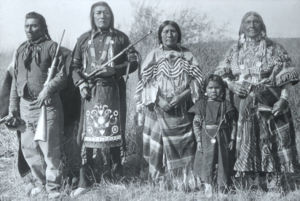Bannock
The Bannock or Banate are an Indian - tribe from the Shoshone branch of the Uto-Aztec language family. They speak the same dialect as the Northern Paiute from which they have split off. They called themselves Nimi Pan a'kwati , Bana'kwut or Panaiti ("water people"). The neighboring Shoshone also referred to the Bannock as Panaiti.
The Bannock lived with their sub-tribes, the Shohopanaiti ("Cottonwood-Bannock" - cotton tree Bannock or also Poplar Bannock), Yambadika (Yap root eater), Waradika (rye grass seed eater), Penointikara (honey eater) and Kutshundika (buffalo eater), in the Snake River Plain in the south of what is now the US state of Idaho , as well as in adjacent parts of western Wyoming , eastern Montana and eastern Oregon . The same territory inhabited the Northern Shoshone , who were culturally almost identical. Due to the strong connection between the two peoples, a very similar story developed.
They felt they were culturally superior to their neighboring tribes, especially in war, and were therefore sometimes known to the whites as robber Indians .
The culture of the Bannock was very similar to the Plains cultures. Seasonal migrations in summer took them west to Shoshone Falls to catch salmon, hunt small game, and gather berries, and in fall to the northeast to the Yellowstone area of Wyoming and Montana to hunt buffalo. The hunt for buffalo required a good collaboration with the Shoshone, with whom they shared a common enemy in the dreaded Blackfoot who controlled the buffalo hunting grounds in Montana.
Before 1853, a smallpox epidemic decimated the Bannock. In 1867 they were defeated by the US Army and in 1869 they were relocated to the Fort Hall reservation in Idaho, from which they soon moved to the Rocky Mountains due to the high mortality rate . The Bannock were few in number, probably never exceeding 2,000 tribesmen, but they had considerable influence over their more peaceful neighbors, inciting them to riot and raid the whites. Hunger, frustration with the disappearance of the buffalo and the insensitive reservation policy of the US government led to the Bannock War in 1878 , which ended with the massacre of 140 Bannock men, women and children at Charles Ford in Wyoming.
The independent culture of the Bannock did not survive the restrictions imposed by reservation life. By 1900 there were only about 500 Bannock left, many of whom were married to Shoshone. Today the Bannock reside with the Northern Shoshone in the Fort Hall Reservation. Of around 6,000 Bannock in 1999, 1,631 spoke their mother tongue.
To revive the culture, the residents of the reservation were granted the right in 2006 to hunt buffalo again north of Yellowstone National Park in parts of the Absaroka-Beartooth Wilderness .
See also
literature
- John R. Swanton: The Indian Tribes of North America . (= Smithsonian Institution, Bureau of American Ethnology, Bulletin. 145). Smithsonian Inst. Press, Washington DC 1969, ISBN 0-87474-092-4 .
- Warren L. D'Azevedo: Handbook of North American Indians . Volume 11: Great Basin . Smithsonian Institution, Washington DC 1986, ISBN 0-16-004581-9 .
- Gregory E. Smoak: Ghost Dances and Identity. Prophetic Religion and American Indian Ethnogenesis in the Nineteenth Century . University of California Press, Berkeley CA et al. 2006, ISBN 0-520-24658-6 .
Web links
- Website of the Shoshone Bannock tribes (Engl.)
- Northern Shoshone and Bannock (Engl.)
- History of Bannock (Engl.)
- History of the Shoshone Bannock and (Engl.)
- David Dominick: The Sheepeaters. ( Memento of March 2, 2012 in the Internet Archive ), p. 10. (Eng.)
- The Sheep-Eater (Engl.)
Individual evidence
- ↑ Sean Reichard: Crow Tribe Wants to Join Tribal Hunts of Yellowstone Bison. Article on yellowstoneinsider.com, February 16, 2018, accessed February 18, 2020.

